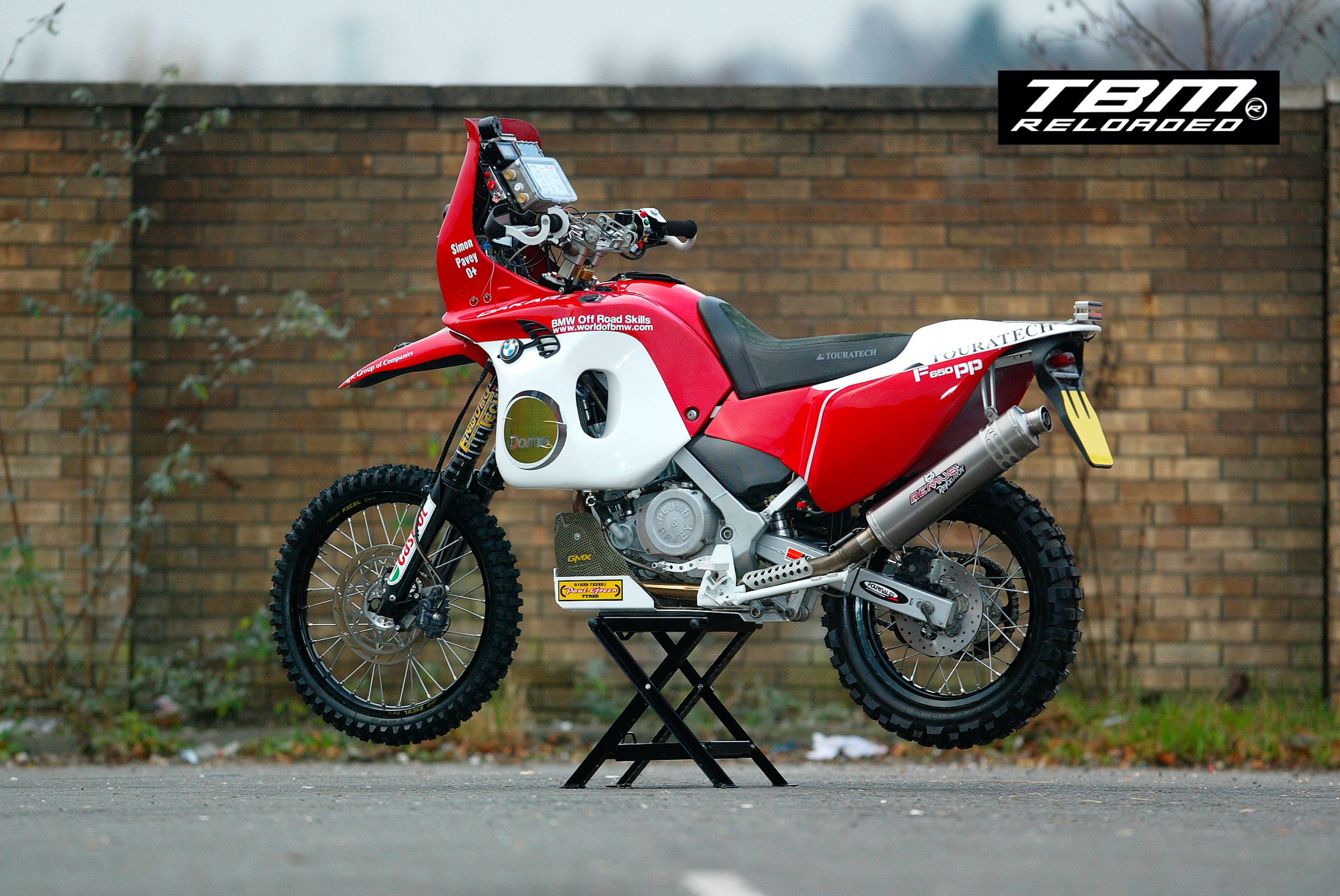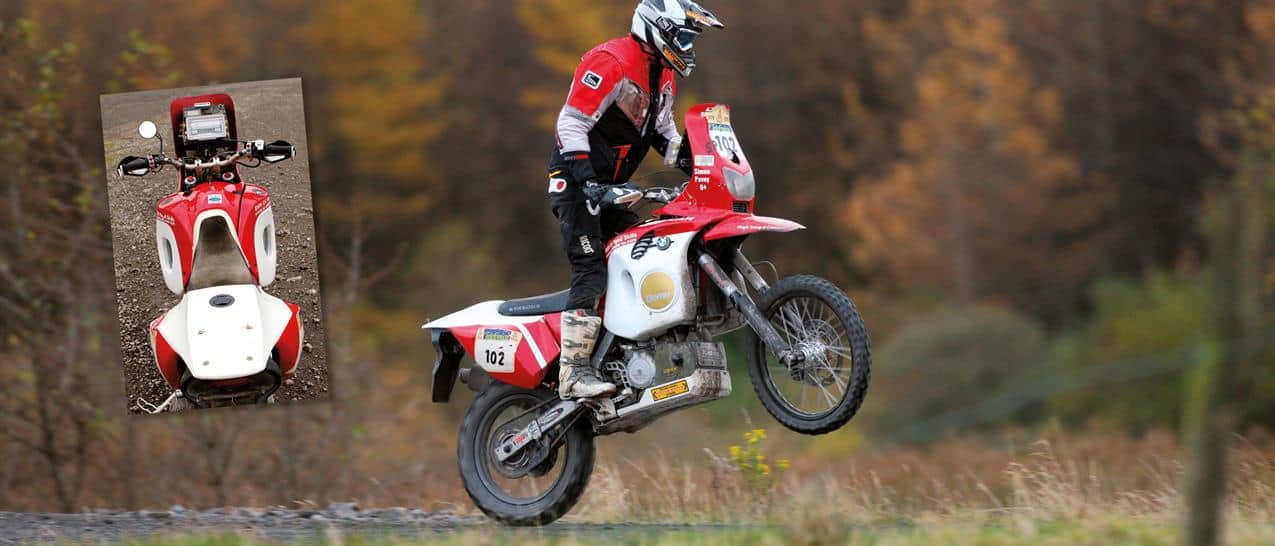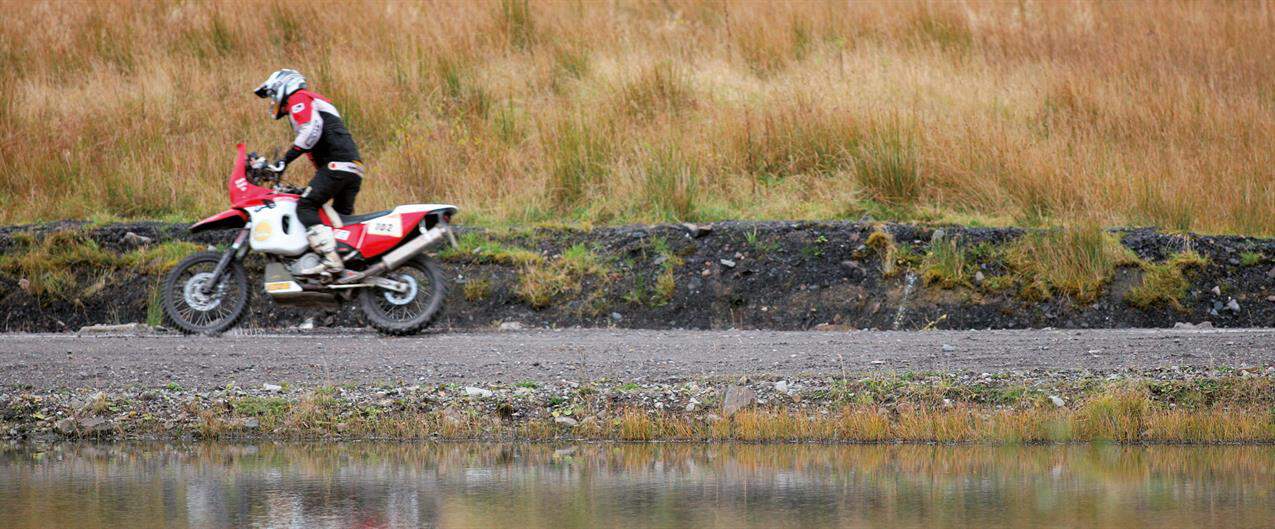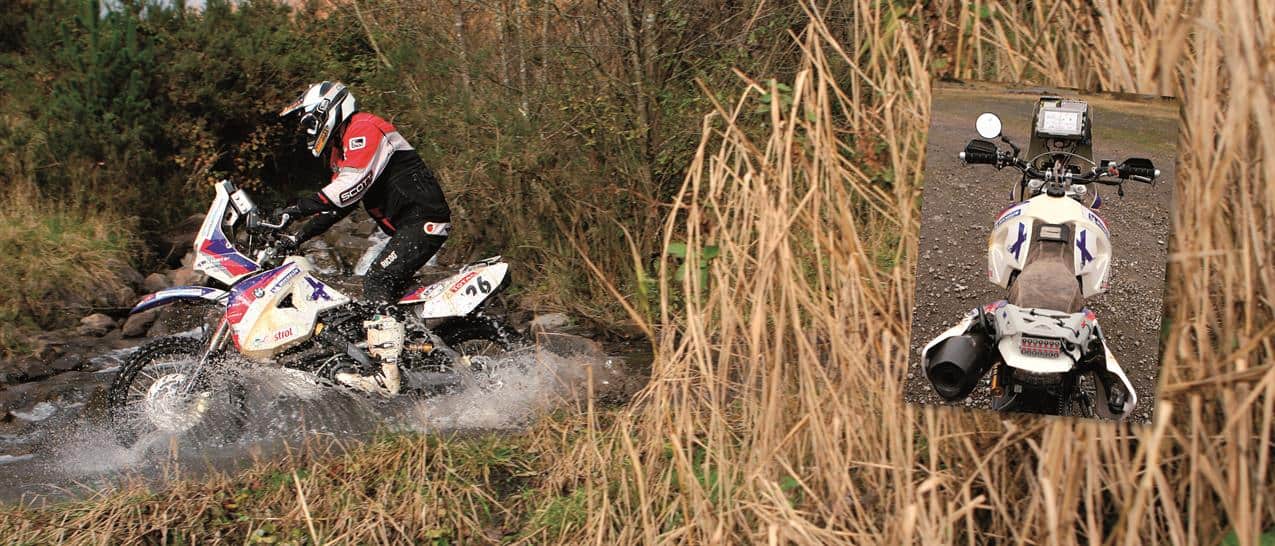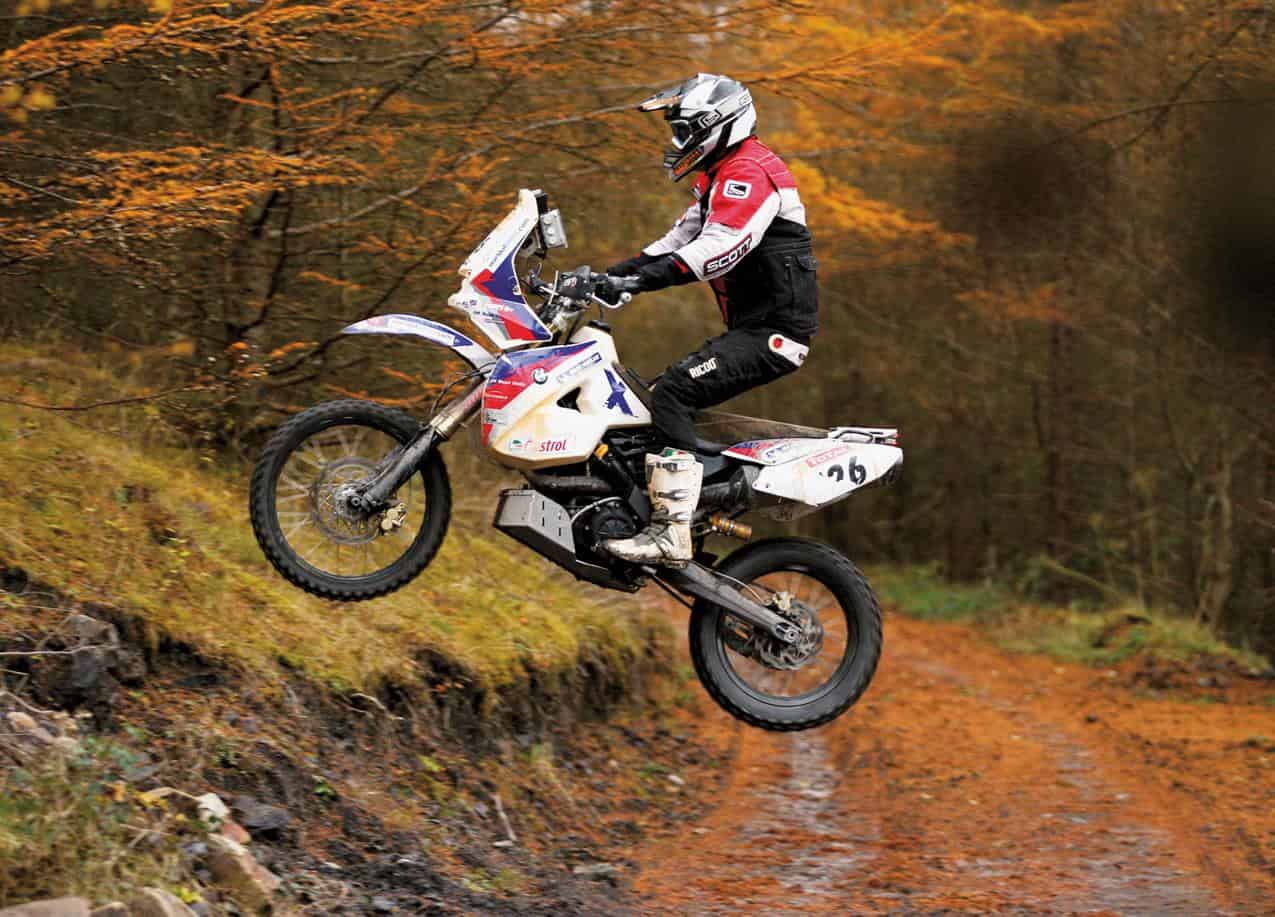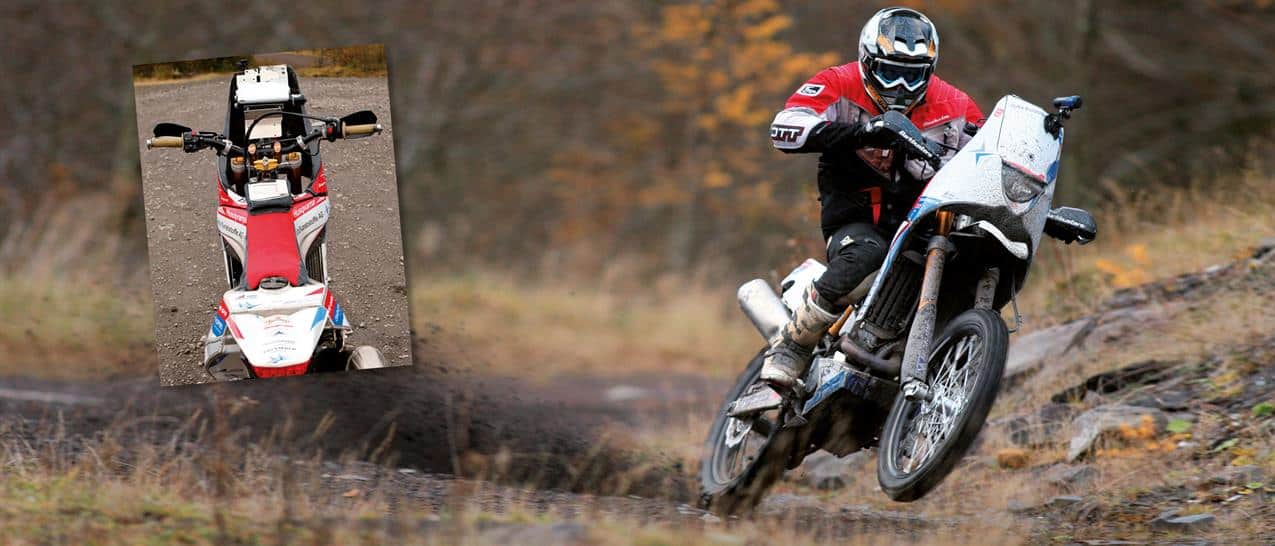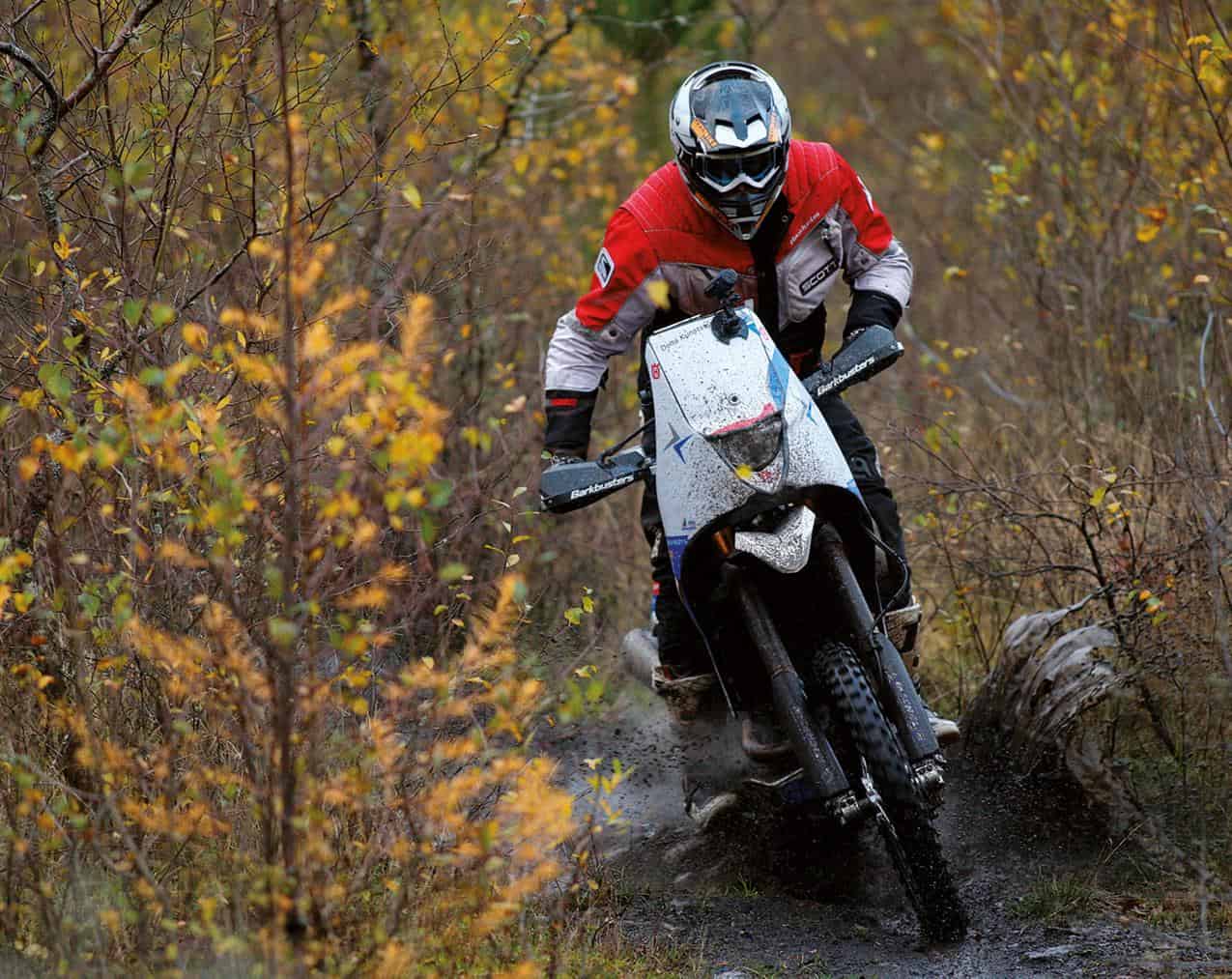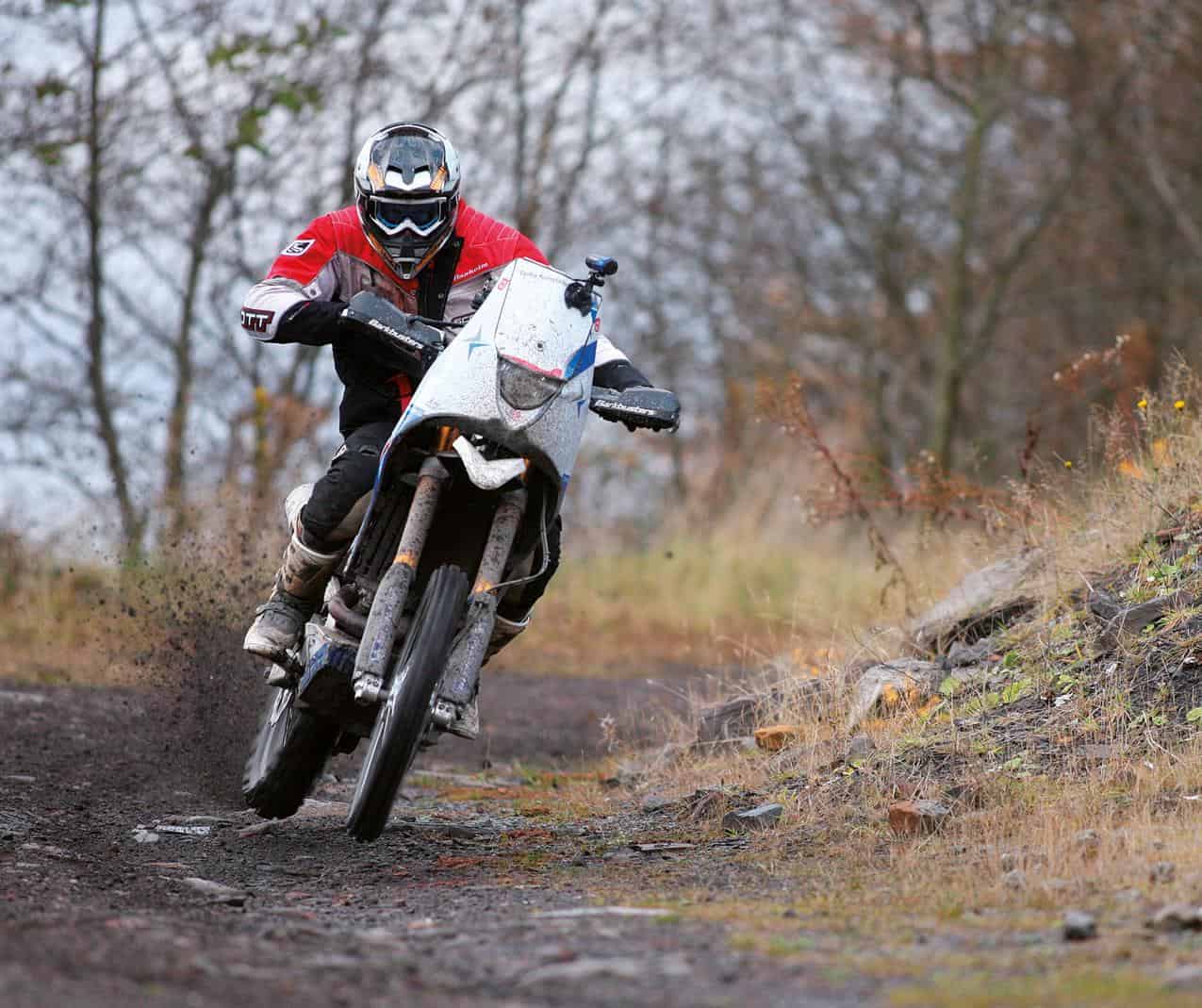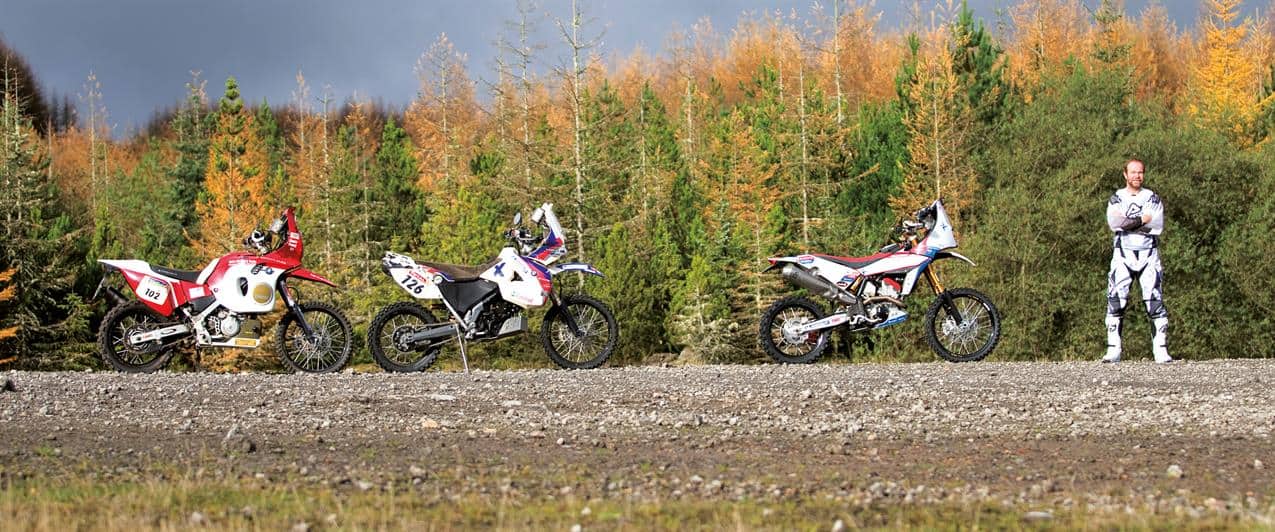Over the last fifteen years we’ve seen the biggest changes in machinery in the Dakar’s history. RUST charts the evolution of the modern-day rally bike from the point of view of Si Pavey, long time Dakar competitior…
The evolutionary curve of the rally bike has spiked. Ten years ago riders were battling against quarter-ton beasts, carrying a mighty 50L of fuel. But in a few short years things have changed and nowadays a fully-kitted desert bike weighs the same as a mud-covered DR-Z400, with tanks holding ‘just’ 25 litres of juice.
From the comfort of an armchair it’s easy to imagine just how much of a difference that makes to a rider. But to fully understand how and why the bikes have changed we need to look a little deeper than just those basic figures. There’ve been some key changes over the past decade and this line-up of one man’s privateer rally machines illustrates that perfectly. The bloke behind these bikes? Top man at BMW/Husqvarna Off Road Skills and Dakar addict, Si Pavey…
Faired Enough
Without getting too engrossed in rally history and charting the rise and fall of certain makes ‘n’ models, it didn’t take long for the earliest Dakar bikes – essentially the open class trailies of the day with massively swollen fuel tanks – to morph into the kind of machines that are immediately recognisable as rally bikes. From the inaugural race in 1979, it was the mid ‘80s when the bikes gained their defining look. And to what do I attribute this fundamental change? The enclosed fairing. Of all the rally accoutrements it’s the one part that you can slap on a dirtbike to give it that instant ‘desert’ look.
However, this was a time when almost every manufacturer built a big trailie bedecked in bodywork and, conveniently for them, the technology of the day demanded decent displacement to cope with the mileages involved in the race. So it was easy for marketing men to make a link between racebike and showroom model – something which has been largely missing from the rally scene over the past decade…
Look at the silhouette of something like an ’87 Honda NXR750 and it isn’t too dissimilar to a pre-450 class machine 20 years its junior. And there’s a good reason for that because, as Si puts it, ‘all of those bikes – the LC4 KTMs, Ténérés etc – were ‘roadbikes’.’ The manufacturers took their big trailbikes (or ‘prototypes’ which closely resembled them) and modded them for rallying… Which is exactly what Si did with the oldest bike here, a 2002 BMW F650GS.
BMW F650GS
Si’s first Dakar was aboard a Honda XR600 and he’s even competed the rally on a CCM. But ever since his tie-up with the Bavarian Motor Works he’s headed for the sands on Munich-made tackle. And at the start of this century that meant there was really only one bike to choose from: the F650GS.
Si’s 650GS is a bike which has evolved in itself as it’s been to Dakar three times. Okay, strictly speaking it’s only been to Dakar once, as Si’s two DNFs from eight starts came aboard this bike. Each subsequent outing brought with it a number of changes, which ultimately resulted in him reaching Lac Rose aboard the bike in 2005.
The red and white machine started out as a 2002-model F650GS. You might be expecting to learn that it came out of a crate and was stripped for rally prep – I know I was – but that certainly wasn’t the case. The bike did a season at the Off Road Skills school before it was torn-down for the transformation into a rally racer.
At the time the only real option for a privateer team running BMWs was to use Touratech parts, so Si and then-teammate Nicky Plumb put a call in to their HQ. The Germans said ‘ja’, and the pair subsequently spent a week in a Niedereschach workshop ‘eating pizzas and spinning spanners’. Incidentally ‘eating pizza is very important for the privateer rally racer’, laughs Si, referring to the long hours spent prepping bikes in the workshop.
The 650’s motor, electrics (aside from the rally additions), swingarm, and airbox were all left as standard. The only powertrain parts that were changed were the exhaust and the air filter.
The fuel tanks (front and rear) and nav gear are Touratech parts, albeit the tanks were adapted with Dzus fasteners so that they could be removed quickly and easily. ‘They need to be when you take them off every day’, remarks Si. And those weren’t the only parts which came in for some modifications. ‘Every time we build a Dakar bike, well, we don’t get everything quite right’, he explains, referring to the enormous number of changes required in a rally racer. And those changes can be both off-the-shelf parts and small but crucial build-details, such as the cable routing – crucial so that they don’t chafe through. ‘There are probably more trick bits on this than on any of my other bikes because we had to come up with stuff.’
Another area crucial to the 650s was knowing how to solve problems using other parts from the BMW brand. The bike runs Talon-built wheels with the Somerset company’s front hub, but at the rear the F-GS doesn’t run a conventional hub so a Talon part wasn’t an option. Instead Si fitted a cushdrive from the forerunner to the bike – the ‘Funduro’ – as it’s stronger than the stock part.
The suspension set-up was another area where Si had to work around a problem that was borne from using what is essentially a ‘roadbike’: no-one really made a proper off-road shock for it, largely because there wasn’t really room to fit one. ‘No-one’, as it transpired, except for the French suspension specialists, Fournales. And so the bike runs one of the Gallic brand’s air-sprung/oil-damped units, whilst the front-end is fitted with a pair of 50mm Marzocchis.
‘The suspension evolved and everything needed to be made stronger’, Si recalls. ‘We took a roadbike off-road racing in the harshest conditions. And we made a heavy bike heavier!’
Shift Up
I know the GS is going to feel hefty, yet as I follow Si along the broad access tracks of the Walter’s Arena site (where he runs the BMW Off Road Skills courses) it doesn’t feel at all like any F650 I remember. Where’s the weighty rear-end, and the remote-feeling front? Instead the bike is incredibly well balanced and the riding position, when stood-up at least, seems to poise me right up by the screen in that classic rally ‘attack’ position. Sinking back into the suede seat, and I couldn’t be more comfortable if I were sat in a club chair with a cognac in my hand. It’s as relaxed as any modern adventure bike and ideal for those long tarmac liaison sections through Europe before you reach The Dark Continent.
Turning down a slippery descent and the inevitable happens – the F650 is revealed for what it is: a bloody chunky bit of kit! I can’t see the bottom of the hill, so I’ve no idea whether I can simply let the bike have its head, or if I should rein-it-in in readiness for a 90-degree turn. And so I slow the pace and carefully pick a course down the slick ‘n’ rutted drop through the trees. The Beemer feels like a huge block of granite that I can only pivot on a central axis, tilting from side-to-side rather than actually turning. Sitting down for a turn reveals where that vague front-end was hiding. You can’t ride it like an enduro machine – this a bike that you flow through fast corners and simply muscle through anything slow or technical.
Likewise, the powertrain rewards a smooth riding style. The low first gear revs-out quickly, signing-off early and hitting the limiter far sooner than you think it should. Hook second and you notice a slight gap in the ratios – one which Si recalls giving a few issues when tackling deep sand – though because the shift of cogs doesn’t drop you straight into the meat of the power you do get fantastic drive out of turns rather than stepping sideways. That old Rotax-designed motor always was good at finding grip and that’s certainly the case here, to the point where even when you’ve built up a good head of steam you still have to be incredibly aggressive in order to break traction.
There’s plenty of weight in the flywheel, so the 650 builds revs steadily rather than piling on the coals – another area where it rewards an unhurried approach. Of course, that clunky gearbox the old GS is renowned for is another limiting factor if you try to get overly aggressive, as you can’t snick through the gears with a flick of your toes. It demands a firm boot.
It’s not hard to imagine why the suspension is so crucial on a rally bike, given the speeds, terrain and weight of the machinery involved. But the area that’s easily overlooked is the change in weight between fully-fuelled and running on fumes – scenarios that you’re likely to experience on any given day in the Dakar. Full of fuel this bike probably weighs 240-or-so kilos. Once you’ve burned through 50-ish litres of petrol you’ve dropped to nearer 200kg (fuel not being as dense as water, so weighing less than one kilo per litre). There’s no chance of guzzling through that lot on a gloomy winter’s day in Wales, so the bike’s only half full of gas. Nonetheless it’s enough to show that the set-up easily copes with such a heavy machine without feeling overly firm.
Although it rides very differently than a standard F650, because of its weight and riding position Si’s GS does still feel like a big trailie. Albeit one that is incredibly well set-up for off-road action! I guess I shouldn’t be surprised – that’s more or less what it is!
BMW G650Xchallenge
The Cross Challenge is arguably the most interesting bike here, as it’s the evolutionary step between the lumbering ‘neanderthal’ F650 and the modern day 449. It’s also a machine which Si is particularly fond of as it not only got him to the finish of the 2009 Dakar (the first to be held in South America) but he also rode it in the Transorientale Rally – an 11,000km epic through Russia and China. And it was that race which really moulded the way the bike was built.
‘I wanted something solid and reliable’, explains Si, ‘as I didn’t know what to expect.’ And that longevity is pretty crucial in a race that’s some 2000km longer than the Dakar!
To highlight just how tough that old motor really is Si recounts a tale from the ’09 Dakar. Having already ridden the Transorientale, he fitted a fresh engine before shipping the bike to South America only to get a thorn through the rad (!) in the middle of a stage, which eventually blew the head gasket. On a lot of bikes that would’ve been game over, but on the 650 Si simply rode-on, stopping every so often to let the motor cool. At the end of the day he swapped it for the engine that’d done the Transorientale and that motor got him to the end of the event…
As with the F650, the Xchallenge’s engine was left largely stock, save for an Akrapovic pipe and a BMW Motorsport CDI unit which allows it to rev slightly higher. The chassis is where all of the work took place. Ordinarily the fuel tank on the 650X is under the seat, and in this case its been added to with that bulbous Safari/Touratech part upfront. As with the 449, the bike only carries 25L, which thanks to shorter distances between refuelling nowadays, is sufficient. As Si’s spannerman, Evan Davis, explained, when you start adding more fuel you end up burning more because you’ve got to carry that extra weight. So you then need to add even more fuel…
Unlike the F650, the aftermarket did cater for the G650’s suspension and an Ohlins unit was used in place of the OEM air-shock – a modification many owners made when the standard part proved unreliable if ridden hard off-road.
At the front-end Si found that the standard forks couldn’t cope with the increased weight and rally-raid speeds. He bent a number of forklegs whilst testing the 650, before coming up with a solution to the problem. Building the bike on a privateer budget, he couldn’t stretch to the set of bespoke triple clamps that a switch to aftermarket forks would’ve demanded, so instead turned to BMW for some technical support…
They suggested using the forks tubes from the 1200cc HP2 mega-trailie as, although visually similar to the Xchallenge’s parts and likely to slip straight into the 650’s clamps, they were much stronger. Si did just that, though he ditched the internals in favour of a set from some higher-specced Marzocchi Shivers.
Really Shifting
As the Cross Challenge was loosely based on the old F650 you’d be forgiven for thinking the two would feel incredibly similar. They don’t. Despite that bulbous front tank and splayed-out rear side panels the bike feels much smaller than its older brother, to the point that you can actually sit down in the turns and ride it enduro-style, rather than staying up on the pegs. ‘It let’s you be a bit more aggressive’, Si concurs.
Much of this is due to the fact that it uses a proper, flat, dirtbike seat as opposed to the abbreviated perch of the F-GS where there’s a good 12in of fuel tank between the seat and the headstock. It also feels lower, and therefore more reassuring in tighter going. Spinning the bike around on the spot is almost as straightforward as on an enduro bike, whereas aboard the GS it was a more tentative affair.
Of course, one area where the bike is incredibly similar to its older brother is the engine room. Ignoring the more sprightly feel that comes from hauling around a good few kilos less, the steady surge of power is largely the same and there’s an over-riding feeling of being able to conquer any climb that stands in its way. Even in this modern era of fast-spinning, high revving powerplants, it’s an easy engine to love. The notchy gearbox, I’m not so fussed about!
Carrying roughly one-third of the available fuel capacity, the suspension is again bang-on. Whatever the going and whatever the pace, it never kicks… only cossets.
An uphill jump only serves to highlight this. If you’ve ever ridden the Dawn to Dusk you’ll be familiar with this kind of obstacle at the Walter’s site – a steep-ish climb with a track running across the gradient halfway up. Stay on the gas and you can leap this trail, landing on the slope and continuing your ascent.
I follow Si towards the hill, snick third, and dial-in half throttle. The G650 charges upward and I prepare for a heavy landing on the rapidly approaching slope. It never comes. We’d previously had a good laugh about jumping the bike, drawing comparisons with meteorite strikes; dropping safes from great heights; and rattling dinner plates from shelves in nearby Swansea. I brace for the inevitable clang of the suspension hitting its bumpstops but instead it firms-up smoothly as it uses up its travel and we continue on our merry way towards the summit.
Time and again we repeat this feat, the only issue coming when the rocky surface pitches the bike sideways (a little extra throttle pulls the bike straight upon landing) and the crockery of Swansea remains unbroken.
Given the big tank and fairing fitted to the Xchallenge, I half expected it to have regressed slightly towards the F650s ‘big trailie’ feel. Yet, if you’ve ever ridden the standard bike, you’ll know how the experience owes as much to a dirtbike as an adventure sports machine. And that’s the case here…
Husqvarna TE449
This is Si’s practice bike, with plenty of hours on the bore. At the time of riding there was barely two weeks to go before the racebike needed to be ready for scrutineering and even if Evan had finished bolting together the Peru-bound machine there’s no way Si’s going to let us near it.
He views the 449 as a natural progression from the 650X and the GS before it. After all it is, as he says, ‘a G450X with a few tweaks and a six-speed ‘box’.
Focus your eyes past the bodywork, and in much the same way you viewed one of those ‘magic eye’ images which slowly revealed a windsurfing badger or some such nonsense, and you can clearly see the outline of an enduro bike. Refocus to take in the details, and you see that its far more involved than slapping on some extra bodywork. The objective remains the same as the older bikes – the change to a 450 class simply requires a different ‘platform’ – and so you still need to add-on some navigation equipment; a drinking water tank; beef-up the suspension; and carry roughly three times the fuel of a standard enduro bike.
Much of this Si has achieved by using parts manufactured by the Portuguese Bianchi Prata team – Dakar-proven kit that the experienced outfit both use themselves and sell off-the-shelf. The bashplate, fairing and navigation tower all come from Portugal, though it’s their fuel tank that looks particularly trick. The stock TE runs an alloy subframe and rear-mounted tank, dressed with slimline plastics. The Bianchi Prata tank replaces this back-end with a one-piece alloy tank/subframe, into which you can somehow cram almost 25-litres of fuel.
The fact that the Husky runs a rear-mounted tank as standard means that Si can keep the bike as close to standard as possible. The airbox and fuel injection set-up are mounted at the front of the bike and can be left alone. Similarly, save for the addition of the nav gear, the wiring is relatively simple and as near to stock as it can be. Everything is taken care of by the ECU and when you turn off the motor with the push-button killswitch EVERYTHING shuts down. On the other bikes there was quite a rigmarole flicking toggle switches and ensuring each button was in the right position. Now there’s no chance of Si leaving his (LED) headlight on..!
Speaking of which, the move to LEDs means that there’s less strain on the battery, which is already under pressure because the nav gear draws a lot of power. A SuperB lithium battery is not only lighter than the equivalent sized standard part but also holds more juice, and Si chose to complement it with a Trail Tech dashboard as it’ll tell him if he’s losing his spark!
Without a kickstart, jump-leads are a crucial part of his rally toolkit. A tired battery deep in the dunes has the potential to end his race, and Si elaborates on how he puts together his pared-down toolkit: ‘A chain breaker is far more important than a spare clutch lever. I can ride out of stage without the lever but not without a chain!’
Shift Light
Blatting around the Walter’s rally stage – an up ‘n’ down, round ‘n’ about mix of decreasing radius turns and flickflack esses that loosely resembles a cobra curled in a basket – the only thing to suggest that I’m not riding a standard enduro bike is the clatter of a fibreglass fairing that’s seen months of test-riding and training. Stood on the pegs, looking for the vanishing point of each turn, I don’t notice the nav-gear tower or the bulging ally fuel tank behind each leg. On my first ever ride of a TE449 on the bike’s launch in the summer of 2010 I commented that it’d make the basis for a great rally bike, and right now it’s feeling made for that role.
In the company of two thudding 650s the motor, which compared to most enduro lumps is incredibly smooth and linear, feels like it lacks torque and needs revving to get the best out of it. But unlike the 650s you CAN rev it, and when you do it’s devastatingly quick.
Less weight than the 650s makes it easier to brake later into the turns and maintain a higher corner speed. On the way out of the slowest bends it doesn’t drive forward in that same deliciously smooth manner because you’re balancing building the revs with a power delivery that’ll provide a lairy powerslide if you give it too much gas. Once you’ve got the power down, it lunges forward and keeps building speed until you run out of room and jump back on the brakes. Our test day is the first time out for an oversize (300mm) front disc from London company All Bike Engineering and it’s working a treat.
The chassis is beautifully composed and at speed that tall-and-long sensation that afflicts the standard enduro 449 in an enduro setting has completely disappeared. The standard suspension has been swapped-out for an Ohlins units direct from the factory (which came with advice on the settings too – a real boon for a small privateer team) and because we haven’t brimmed the tanks, I’m expecting it to feel too firm, especially given the nature of the terrain. Trails that’ve seen plenty of GSs up and down them, and wider tracks where WRC cars have slithered broadside across the loose surface, are plastered with areas of ultra-slick, super-slippery rock. But no, the Husky glides over the ground with a surfeit of feedback, transmitting exactly what’s happening beneath it without ever wallowing or crashing through its travel. Whilst the weight of the F650 had me tip-toeing through greasy slower corners, on the 449 I can attack them.
With far less fuel onboard than back in the early days, Si explains how setting up the suspension isn’t quite so onerous as it once was. It’s still imperative that you get it right, only the aforementioned difference between ‘full’ and ‘empty’ isn’t so pronounced. And when it comes to the TE, he reckons that the large rear-mounted tank actually complements the bike’s handling. It certainly didn’t do anything untoward as we lapped the Walter’s rally course; trickled along soggy singletrack; and leapt small drainage ditches around the site.
I’d have no hesitation in taking a bike like Si’s pretty much anywhere I’d take a regular enduro machine, whilst at the same time it feels like an incredibly well-sorted rally bike – largely due to its poise at speed.
Shift Pattern
If you’ve any interest in riding big bikes off-road then there’s still a lot to like about the old skool rally bikes. When the going opens out they’re wonderfully unhurried, and tackling technical terrain brings with it a great sense of achievement. If you make it through, that is, and with the Dakar evolving and becoming far more varied in its route, it certainly makes sense for the bikes to adapt to suit.
Si’s initial interest in rallies was borne from the desire to get as much bike-time as possible. He loved the fact that you spent hours in the saddle, seeing vast swathes of terrain pass under the wheels. And although he’s since become known as something of a big bike specialist – teaching people how to hit the dirt on Boxer BeeEms – his first rally bike was actually a YZ250 kitted-out with an oversize tank.
‘I’ve now got a bike that I can actually enjoy riding everywhere’ Si laughs, referring to the 449 whilst acknowledging that there’ve been times when he’s found it a slog racing a quarter-ton machine.
‘The desert still bites’, he states, talking about crashing in the sands, ‘only now the bike that’s coming after you isn’t so big! When you go over the bars in Wales the ground’s pretty squidgy because it’s been wet for 2000 years!’
The 450 class hasn’t just brought new manufacturers into the Dakar, or teased factory involvement out of the Japanese, it’s also allowed a whole new breed of rider to get involved. As in top-level enduro, we’re now seeing motocrossers getting into rallying…
Previously it’d been hard to imagine tempting an MXer into blatting across a desert on a rally bike: a machine that weighs more than twice that of an MX bike. Nowadays there’ve been a number of motocross riders – such as HRC Honda’s British racer, Sam Sunderland – come into the sport knowing that they can feel at home pushing a 450cc machine very hard. There may be a few extra obstacles for them to overcome, such as the navigation element; maintaining machine longevity; and working out how to fit low profile tyres to a Kamaz support truck for paddock-posing, but once they’ve got those licked then we’re likely to see some new names near the top of the leaderboard.
The number of factory riders nowadays supports this. Greater interest in the race from manufacturers, media and sponsors naturally brings with it more teams, but you still need to find pro-racers willing to take up the challenge.
Ironically, part of the rise in Dakar interest can be levelled at the burgeoning adventure sports market. ‘Everyone likes to watch some racing’, comments Si when I run this theory past him, ‘and the Dakar is the most relevant to those guys. They’re probably not going to be into the EWC…’ Why would you consider this ironic? Because barely a handful of years ago Dakar bikes were similar to those adventure machines manufacturers are now clamouring to build. Only nowadays the rally bikes are far closer to enduro machines than they are big trailies..! So maybe the interest comes not so much from the machinery but from the terrain, the epic mileage and the incredible scenery involved.
Whatever the reason, what’s clear is that the Dakar is now more popular than ever. From the comfort of your armchair it’s eminently enjoyable. And with the shift to 450-powered machines, doubtless the same is true if you’re seeing the race from a suede-covered saddle…
You can ride with Si at Off-Road-Skills by going to the website below, don’t forget to tell them RUST sent you!

